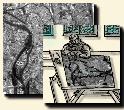 |
 |
![]()
![]()
Two types of basic operators able to extract linear elements can be usually observed:
In recent research, can be noticed a tendency to integrate various types of operators in order to make them cooperate. This leads to more robust methods which provide more reliable results.
Thanks to the increase in the performances of computers, research is directed towards new operators, more complex but also closer to human perception, such as neural networks, fuzzy reasoning, etc.
These method are often sensitive with noise and thus very related to the nature of image. An accurate adaptation of the operator is difficult and leads generally to an over-segmentation, or to an under-segmentation. Moreover they do not always provide perfectly connected chains. The pixels selected constitute only ``seed'' points (``seeds''), and it is necessary to use aggregation operators to link the pixels in chains.
But two disadvantages must be noticed about these processes:
In the case of lineaments, it is a matter of connecting end to end the segments to form roads or rivers.